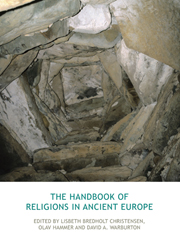Book contents
- Frontmatter
- Contents
- A note on Greek and Latin sources
- Abbreviations and short titles
- 1 Introduction
- PART I PREHISTORIC RELIGIONS
- PART II ANCIENT EUROPE IN THE HISTORICAL PERIOD
- 12 Minoan and Mycenaean religion
- 13 Etruscan religion
- 14 The religions of the Iberian Peninsula
- 15 Italic religion
- 16 Roman religion
- 17 Ancient Greek religion
- 18 The Graeco-Roman cult of Isis
- 19 The cult of Mithras
- 20 Religious Platonism: philosophy and religion in the Platonic tradition
- 21 Insular Celtic religion
- 22 Continental Germanic religion
- 23 Pre-Christian Anglo-Saxon religion
- 24 Old Norse religion
- 25 Slavic religion
- 26 Baltic religion
- 27 Religion in prehistoric Finland
- 28 Sami religion
- Timeline of key dates
- Contributors
- References
- Index
22 - Continental Germanic religion
from PART II - ANCIENT EUROPE IN THE HISTORICAL PERIOD
- Frontmatter
- Contents
- A note on Greek and Latin sources
- Abbreviations and short titles
- 1 Introduction
- PART I PREHISTORIC RELIGIONS
- PART II ANCIENT EUROPE IN THE HISTORICAL PERIOD
- 12 Minoan and Mycenaean religion
- 13 Etruscan religion
- 14 The religions of the Iberian Peninsula
- 15 Italic religion
- 16 Roman religion
- 17 Ancient Greek religion
- 18 The Graeco-Roman cult of Isis
- 19 The cult of Mithras
- 20 Religious Platonism: philosophy and religion in the Platonic tradition
- 21 Insular Celtic religion
- 22 Continental Germanic religion
- 23 Pre-Christian Anglo-Saxon religion
- 24 Old Norse religion
- 25 Slavic religion
- 26 Baltic religion
- 27 Religion in prehistoric Finland
- 28 Sami religion
- Timeline of key dates
- Contributors
- References
- Index
Summary
It is by no means easy to put a qualified date from when we can start talking about “Germanic religion”, the term “Germanic” being none too easy to define to begin with. Geographically speaking, we are dealing with the area covering the north German plains, the Lowlands and southern Scandinavia, as well as those areas settled by tribal entities described as Germanic on linguistic grounds and settling large tracts of land north of the Alps and west of the river Oder with the exception of areas already inhabited by Celts: Gaul, the Alps, Britain and Ireland. This changed during the course of the later Iron Age and Migration periods, and other areas were settled or conquered by Germanic tribes around the lower and middle Danube (Goths, Langobards and Rugians), Northern Italy (Goths and later Langobards), southern Gaul (Goths), the Iberian Peninsula (Goths and Vandals) and parts of Northern Africa (Vandals). Even given these geographical limitations, it is still difficult historically speaking to decide when we can begin talking about a “Germanic religion”, if indeed such a single entity ever existed.
According to modern scholarship it is not viable to attempt to trace the origins of Germanic religion back to the Neolithic and Bronze Age cultures of both northern and central Europe, even though there is clear evidence of strong continuities between the Bronze Age and the Iron Age cultures. The earliest manifestations of a “Germanic religion” come from archaeological finds dating from around 400 BCE and later.
- Type
- Chapter
- Information
- The Handbook of Religions in Ancient Europe , pp. 291 - 304Publisher: Acumen PublishingPrint publication year: 2013



